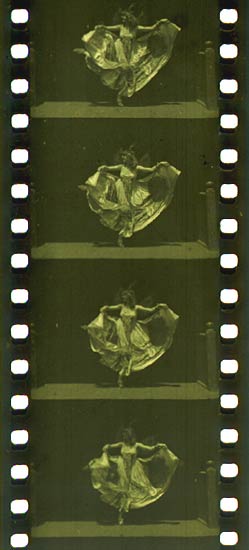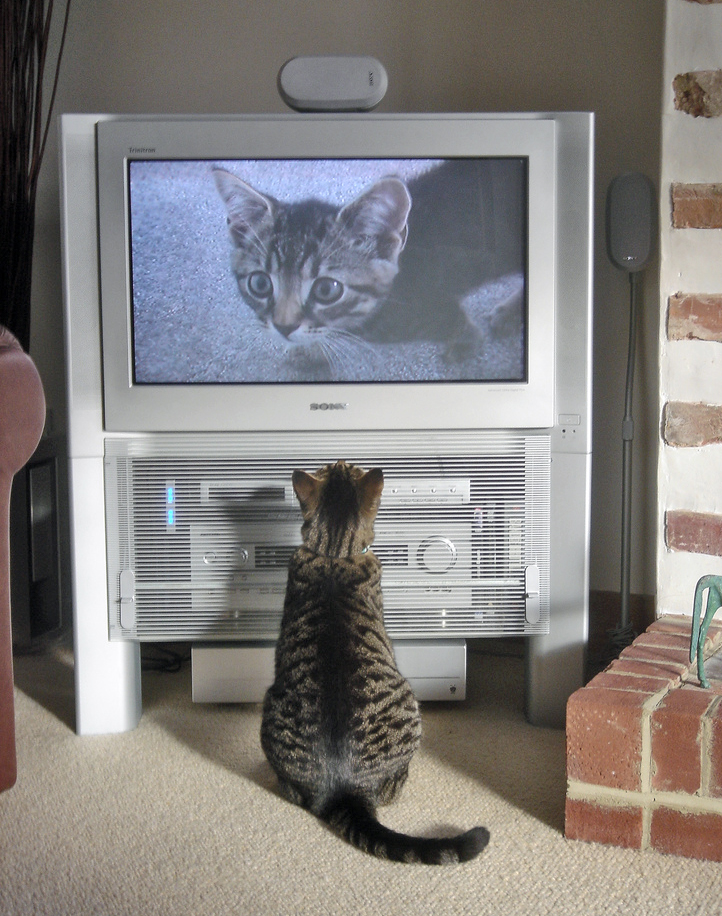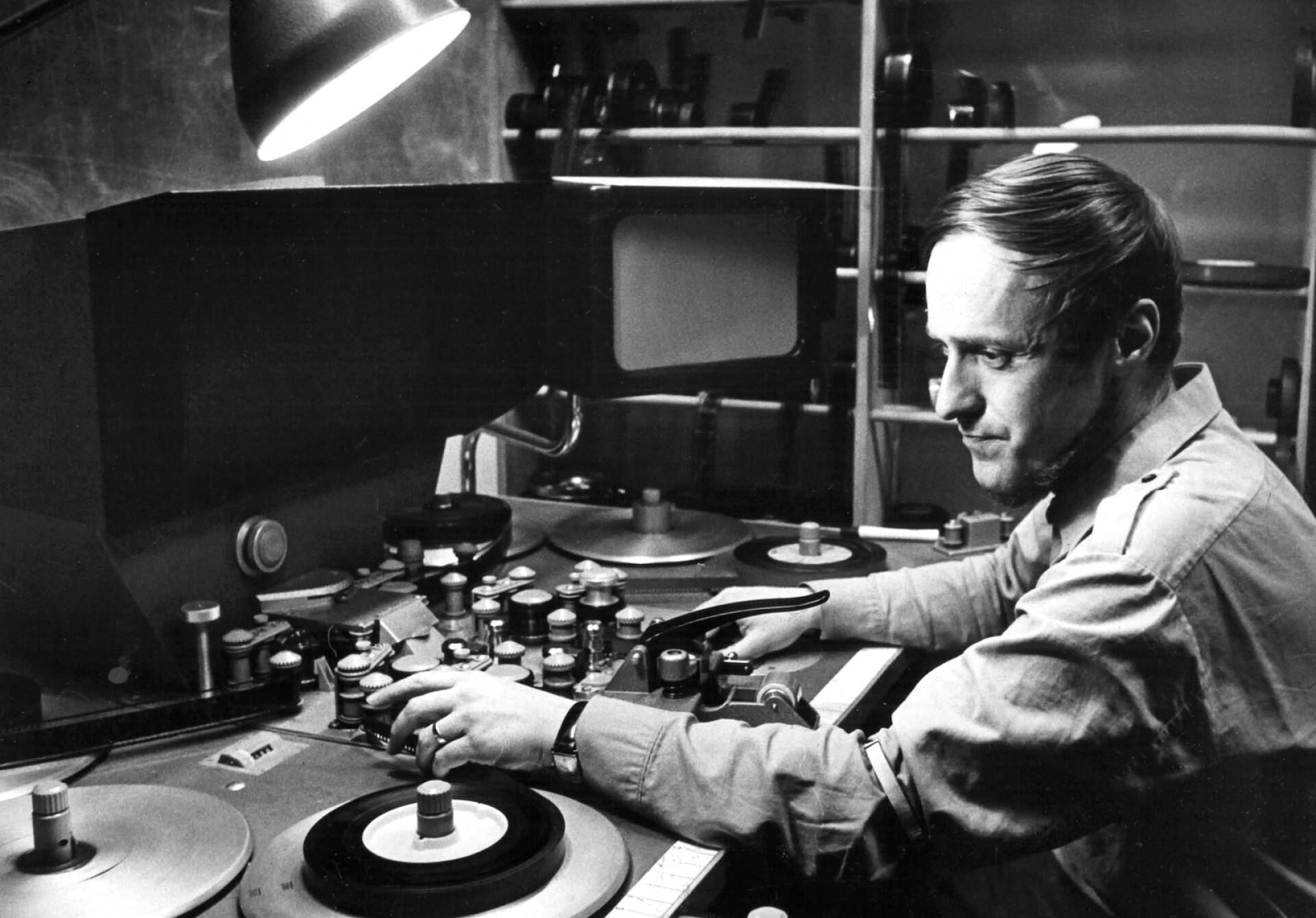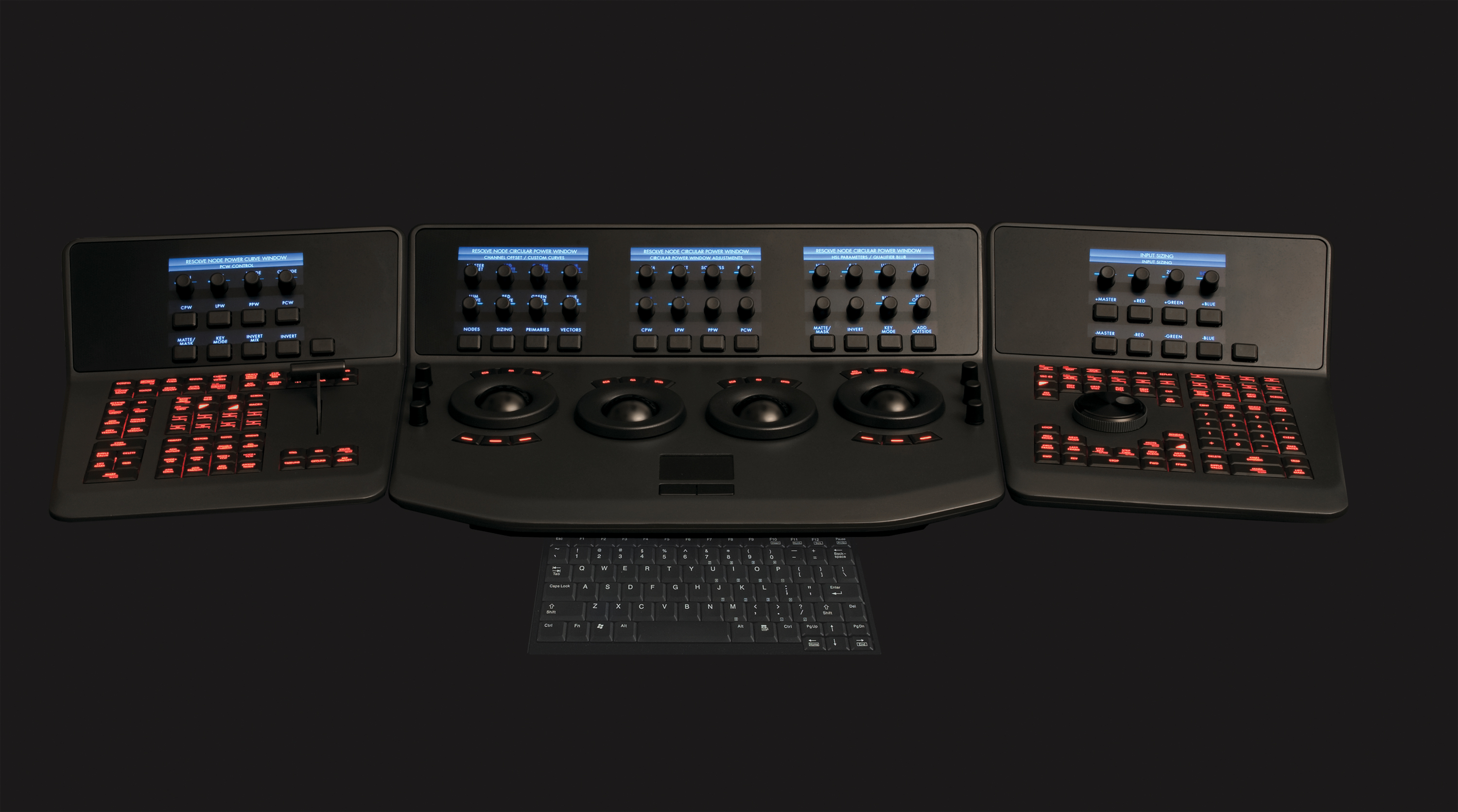|
Three-two Pull Down
Three-two pull down (3:2 pull down) is a term used in filmmaking and television production for the post-production process of transferring film to video. It converts 24 frames per second into 29.97 frames per second, converting approximately every four frames into five frames plus a slight slow down in speed. Film runs at a standard rate of 24 frames per second, whereas NTSC video has a signal frame rate of 29.97 frames per second. Every interlaced video film frame, frame has two fields for each frame. The three-two pull down is where the telecine adds a third video field (a half frame) to every second video frame, but the untrained eye cannot see the addition of this extra video field. In the figure, the film frames A–D are the true or original images since they have been photographed as a complete frame. The A, B, and D frames on the right in the NTSC footage are original frames. The third and fourth frames have been created by blending fields from different frames. Video 2: ... [...More Info...] [...Related Items...] OR: [Wikipedia] [Google] [Baidu] |
Film Stock
Film stock is an analog medium that is used for recording motion pictures or animation. It is recorded on by a movie camera, developed, edited, and projected onto a screen using a movie projector. It is a strip or sheet of transparent plastic film base coated on one side with a gelatin emulsion containing microscopically small light-sensitive silver halide crystals. The sizes and other characteristics of the crystals determine the sensitivity, contrast and resolution of the film.Karlheinz Keller et al. "Photography" in Ullmann's Encyclopedia of Industrial Chemistry, 2005, Wiley-VCH, Weinheim. The emulsion will gradually darken if left exposed to light, but the process is too slow and incomplete to be of any practical use. Instead, a very short exposure to the image formed by a camera lens is used to produce only a very slight chemical change, proportional to the amount of light absorbed by each crystal. This creates an invisible latent image in the emulsion, which ... [...More Info...] [...Related Items...] OR: [Wikipedia] [Google] [Baidu] |
Film Recorder
A film recorder is a graphical output device for transferring images to photographic film from a digital data, digital source. In a typical film recorder, an image is passed from a host computer to a mechanism to expose film through a variety of methods, historically by direct photography of a high-resolution cathode-ray tube (CRT) display. The exposed film can then be developed using conventional developing techniques, and displayed with a slide or motion picture projector. The use of film recorders predates the current use of video projector, digital projectors, which eliminate the time and cost involved in the intermediate step of transferring computer images to film stock, instead directly displaying the image signal from a computer. Motion picture film scanners are the opposite of film recorders, copying content from film stock to a computer system. Film recorders can be thought of as modern versions of kinescopes. Design Operation All film recorders typically work in the s ... [...More Info...] [...Related Items...] OR: [Wikipedia] [Google] [Baidu] |
Faroudja
Faroudja Labs was a San Franciscobased IP and research company founded by Yves Faroudja. Faroudja Labs shouldn't be confused with Faroudja Enterprises, Yves Faroudja's latest venture. Faroudja specialized in video processing algorithms and products. Its technologies for deinterlacing and inverse telecine have received acclaim within the consumer electronics industry and have been widely used in many electronic devices, such as TV sets, set-top boxes, and video processors. Efforts by Faroudja generated more than 65 patents and provided technology licenses to consumer electronics companies, and helped receive three Technology & Engineering Emmy Awards (one for advanced encoding techniques, a lifetime achievement for Yves Faroudja, and one for HDTV upconversion used in network broadcast applications),Emmy Award Info [...More Info...] [...Related Items...] OR: [Wikipedia] [Google] [Baidu] |
Display Resolution
The display resolution or display modes of a digital television, computer monitor, or other display device is the number of distinct pixels in each dimension that can be displayed. It can be an ambiguous term especially as the displayed resolution is controlled by different factors in cathode-ray tube (CRT) displays, flat-panel displays (including liquid-crystal displays) and projection displays using fixed picture-element (pixel) arrays. It is usually quoted as ', with the units in pixels: for example, ' means the width is 1024 pixels and the height is 768 pixels. This example would normally be spoken as "ten twenty-four by seven sixty-eight" or "ten twenty-four by seven six eight". One use of the term ''display resolution'' applies to fixed-pixel-array displays such as plasma display panels (PDP), liquid-crystal displays (LCD), Digital Light Processing (DLP) projectors, AMOLED, OLED displays, and similar technologies, and is simply the physical number of columns and rows of pi ... [...More Info...] [...Related Items...] OR: [Wikipedia] [Google] [Baidu] |
Digital Intermediate
Digital intermediate (DI) is a motion picture finishing process which classically involves digitizing a motion picture and manipulating the color and other image characteristics. Definition and overview A digital intermediate often replaces or augments the photochemical timing process and is usually the final creative adjustment to a movie before distribution in theaters. It is distinguished from the telecine process in which film is scanned and color is manipulated early in the process to facilitate editing. However the lines between telecine and DI are continually blurred and are often executed on the same hardware by colorists of the same background. These two steps are typically part of the overall color management process in a motion picture at different points in time. A digital intermediate is also customarily done at higher resolution and with greater color fidelity than telecine transfers. Although originally used to describe a process that started with film scanning ... [...More Info...] [...Related Items...] OR: [Wikipedia] [Google] [Baidu] |
Pandora International
Pandora International was an Primetime Engineering Emmy Awards, Emmy award winning, English maker of hardware and software for telecine control and Color grading, colour correction in post production film editing. History Pandora International began trading in 1988 led by Steve Brett and Martin Greenwood, initially in Northfleet. Pandora's twin Motorola 68020 Pogle could control telecine machines such as the Spirit DataCine FDL 60, FDL 90 and Quadra, and four video tape decks, for field (video), field accurate editing including Three-two pull down, three-two sequence control. Later versions used Silicon Graphics SGI Indy and SGI O2 computers. Pandora's DCP external colour corrector implemented Rec. 601, Rec 601 and was one of the first able to directly accept digital video, digital input from film or video tape, with support for NTSC and PAL. The PiXi colour corrector was launched in 1995, to replace the DCP and supported video resolutions up to 1080i, 1920x1080 at 30 frames p ... [...More Info...] [...Related Items...] OR: [Wikipedia] [Google] [Baidu] |
Video Editing
Video editing is the post-production and arrangement of video shots. To showcase excellent video editing to the public, video editors must be reasonable and ensure they have a thorough understanding of film, television, and other sorts of videography. Video editing structures and presents all video information, including films and television shows, video advertisements and video essays. Video editing has been dramatically democratized in recent years by editing software available for personal computers. Editing video can be difficult and tedious, so several technologies have been produced to aid people in this task. Overall, video editing has a wide variety of styles and applications. Types of editing Though once the province of expensive machines called video editors, video editing software is now available for personal computers and workstations. Video editing includes cutting segments (trimming), re-sequencing clips, and adding transitions and other special effects. * Linear ... [...More Info...] [...Related Items...] OR: [Wikipedia] [Google] [Baidu] |
Color Grading
Color grading is a post-production process common to filmmaking and video editing of altering the appearance of an image for presentation in different environments on different devices. Various attributes of an image such as contrast (vision), contrast, color, colorfulness, saturation, detail, black level, and color balance, white balance may be enhanced whether for motion pictures, videos, or still images. Color grading and color correction are often used synonymously as terms for this process and can include the generation of artistic color effects through creative blending and compositing of different layers (digital image editing), layer masks of the source image. Color grading is generally now performed in a digital process either in a controlled environment such as a color suite, and is usually done in a dim or dark environment. The earlier film processing, photochemical film process, referred to as color timing, was performed at a film laboratory, film lab during releas ... [...More Info...] [...Related Items...] OR: [Wikipedia] [Google] [Baidu] |
Da Vinci Systems
da Vinci Systems was an American digital cinema company founded in 1984 in Coral Springs, Florida as a spinoff of Video Tape Associates. It was known for its hardware-based color correction products, GPU-based color grading, digital mastering systems, and film restoration and remastering systems. It was one of the earliest pioneers in post-production products. The company was owned by Dynatech Corporation (Acterna after 2000) for the majority of its lifespan until being bought by JDS Uniphase in 2005 and by Blackmagic Design in 2009. Company history In 1982, Video Tape Associates (VTA), a Hollywood, Florida-based production/post-production facility, began developing the Wiz for internal use and introduced it to the public the following year. The Wiz controlled early telecines such as the RCA FR-35 and the Bosch FDL 60 and offered basic primary and secondary color correction. The American post-production facilities company EDITEL Group asked VTA to build multiple Wiz sy ... [...More Info...] [...Related Items...] OR: [Wikipedia] [Google] [Baidu] |
Color Suite
A color suite (also called a color bay, telecine suite, or color correction bay) is the control room for color grading video in a post-production environment. Technology and specifications The video source could be from: a telecine, a video tape recorder (VTR), a motion picture film scanner, virtual telecine or a direct-to-disk recording (DDR) or the older system called a film chain. A high end broadcast color suite may use a Da Vinci Systems or Pandora International color corrector. If a VTR is the source for the video the room is often called a ''tape to tape'' suite. Many suites are designed to operate as a telecine suite or a tape to tape suite by changing the configuration of the suite. The operator of the suite is usually called a ''Colorist''. If a telecine is the source this is called a ''Film to Tape'' operation. A color suite may use one video standard or be able to change configuration to a number of standards like: high-definition video, NTSC, or PAL or a DI ... [...More Info...] [...Related Items...] OR: [Wikipedia] [Google] [Baidu] |
Color Television
Color television (American English) or colour television (British English) is a television transmission technology that also includes color information for the picture, so the video image can be displayed in color on the television set. It improves on the monochrome or black-and-white television technology, which displays the image in shades of gray (grayscale). Television broadcasting stations and networks in most parts of the world upgraded from black-and-white to color transmission between the 1960s and the 1980s. The invention of color television standards was an important part of the history of television, history and technology of television. Transmission of color images using mechanical scanners had been conceived as early as the 1880s. A demonstration of mechanically scanned color television was given by John Logie Baird in 1928, but its limitations were apparent even then. Development of electronic scanning and display made a practical system possible. Monochrome transmi ... [...More Info...] [...Related Items...] OR: [Wikipedia] [Google] [Baidu] |





